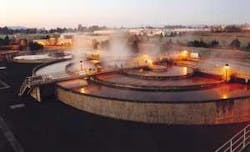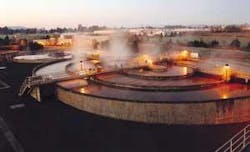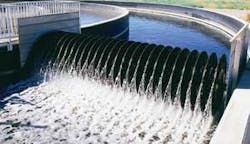By Farid Kade and John Olson
Planned expansion and asset renewal of a water reclamation facility (WRF) in the Chicago suburbs required the need to comply with new stringent nutrient discharge limits. Located in a residential/commercial area, the 1.5 mgd facility currently serves a population of approximately 7,500. The selected biological nutrient removal (BNR) system would have to handle double that capacity over the next few decades and remain odor-free.
The operating company’s engineering firm, Strand Associates of Madison, WI, suggested installing an Orbal® multichannel oxidation ditch from Siemens Water Technologies. Aerated anoxic nutrient removal technology is at the heart of the system, where oxygen is added to a zone that remains anoxic with near zero dissolved oxygen (DO) level. This is accomplished in a two-channel design, with an anaerobic zone built in the outline of the future third channel.
The WRF design includes Sim-Pre® recycle for enhanced denitrification as well as an internal recycle for enhanced biological phosphorus uptake rates and removal. This design allows the new system to meet phosphorus removal requirements using an enhanced biological uptake rate. This zone can eventually be incorporated into the third channel, once it is built, by knocking down the side walls.
One of many such installations throughout the Midwest, the suburban WRF is the first expandable BNR Orbal solution that Strand and Siemens have designed.
Company operators visited the facility in Channahon, IL, before deciding to install the Orbal system. With a few modifications, Siemens and Strand were able to design a system that would meet the operating company’s needs.
“The process has proven to be a reliable solution that meets the nutrient removal and redundancy requirements of the facility,” said Matthew Smith, PE, engineer at Strand Associates. “Operators like it because the solution offers versatility under various loading conditions and energy savings.
“And it will be relatively easy to expand to meet the 2.7 mgd Phase 2 design flow in the future.”
Expandable System
Siemens’ Orbal multichannel oxidation ditch is a complete mix, looped reactor system that can be expanded by either adding on additional aerator assemblies to the existing channels or by adding on an additional channel to the existing channels. The process’ dual basin capability allows for process flexibility and helps meet state standards for redundancy with single basin designs.
Typically, the Orbal basin has three concentric channels, with the outer channel having approximately 50% of the total volume. After screening and optional grit removal, influent enters the outer channel which is operated under an oxygen deficit condition to promote simultaneous nitrification-denitrification. Though the actual oxygen demand of the first channel might be as high as 75% of the total, the aeration discs allotted to this channel supply only 30-60% of the system’s overall oxygen requirements to ensure a constant oxygen deficit condition and an operating DO of zero throughout the channel. The simultaneous nitrification-denitrification environment of the first channel results in an overall denitrification performance rate of more than 80%, without internal recycle.
The inner channel maintains a polishing mode, removing any remaining BOD and ammonia before the flow exits to the final clarifiers.
The middle channel is the transition or “swing” channel in the standard Orbal system. (This channel was not included in the WRF project.) More oxygen is provided by the aerators and the environment transitions from anoxic (as in the outer channel) to aerobic (as in the inner channel). Depending on the BOD load coming in, the conditions found in this channel may be slightly anoxic or slightly aerobic when measured throughout the day.
Disc aeration, with its high oxygen transfer and mixing efficiency, forms the mechanical backbone of the process. Daily fluctuations in oxygen demand are handled by changes in the disc immersion or varying rotation speed. Long-term variations or sudden surges in demand are handled by turning on/off individual assemblies. Individual assemblies span one or more channels, the number of discs allotted per each channel being a function of the oxygen delivery requirements.
A SmartBNR™ control system is incorporated into the design, to provide control operation and VFD speed of the aerators, based on continuous readings from ORP and DO probes and process objectives. The system also has the capability to notify operators of high influent flow during storm events and to suggest changing the location of influent based on influent peak flow factor, if needed.
System Performance
Since the system became operational in December 2008, the Midwest WRF has consistently achieved below 3.0 mg/l TN and 1.0 mg/l TP without tertiary filtration or chemical addition, over 90% TN removal and 75% TP removal.
The Orbal process, with its natural high level of denitrification, its stratified DO levels across its multiple channels, and its low delivery intensity, will typically require 35% less oxygen delivery than a standard, single channel ditch. It is also an efficient nutrient removal system with low energy requirements. Adding on the SmartBNR control system is estimated to reduce the system’s power consumption by 30-40%, compared to conventional systems. Additionally, the control system is able to interface with existing automation, allowing for untended plant operation.
The automated control system and non-fouling aerator discs help minimize maintenance. Operators only need to grease bearings weekly, change the oil in the gearbox every six months, and regularly confirm that everything’s tightened up. They do not have to take the tanks down for equipment repair or replacement.
Additional operator convenience is achieved via the Orbal basin’s complete mix characteristics and ability to operate at high MLSS concentrations, which allows for a high buffer capacity for shock loads. The varying food to microorganism ratios across the channels promotes an MLSS with a low SVI and prevents sludge bulking. WW
About the Authors Farid Kade, PE, is a process engineer for BNR processes and John Olson, a technical sales manager, for Siemens Water Technologies. Both are located in Waukesha, WI. Kade can be contacted via e-mail at [email protected]; Olson, at [email protected].






